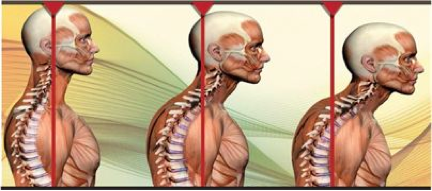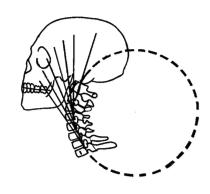By Dr. Oakley
‘Text neck’ is a modern term describing the forward head and neck positions adopted while using your smartphone. According to Dr. Hansraj,1 chief of spine surgery at New York Spine Surgery and Rehabilitation Medicine, it is an epidemic. As he states in an interview in The Washington Post, “Just look around you, everyone has their heads down.”2
According to Dr. Hansraj, an average head weighs about 12 pounds. The more forward your head angle becomes, the greater ‘effective weight’ of your head. At a 60° angle, the head feels like it weighs 60 pounds (as opposed to 12lbs)!1 This adds an extraordinary amount of stress to the structures of the neck including the discs, muscles and ligaments, as well as the bones and nerves.
Poor posture is truly an under-diagnosed modern epidemic. Postural alterations are known to be associated with a plethora of human afflictions from general pain syndromes,3-11 to problems with specific joints such as the hip12,13 and the knee,14 to problems with specific spinal regions such as the flat-back syndrome,15 and cervical kyphosis,11 to local organ ailments such as uterine prolapse,16,17 gastric herniation,18 and respiratory function,19-21 to thinking,19,22 and even to morbidity and mortality.23-27
An ideal neck in neutral posture should have a backward curve, or ‘C’ shape, as in a piece of a circle.28,29 The more often one bends their head forward, the greater the chance of loosing the normal or ideal ‘C’ shape alignment. This leads to a straightening of the neck curve, which predisposes you to neck pain and headaches, as well as numbness and tingling in the arms and hands as in carpal tunnel syndrome.28,29
Even worse, the forward leaning of head posture leads to a worsening of your whole spine. Those older people with excessive forward hunchback postures (termed hyper-kyphosis) have had their bad postures start somewhere – and it typically starts with only a forward head position. As your posture can continue to lean and hunch forward as the years go by, a simultaneous deterioration of your health occurs.
So to avoid and prevent the deterioration of your health by poor postures, it is of prime importance to not only be aware of what postures you adopt throughout the day (including while using your smartphone), but also to get a spine and posture assessment to see where your spine and posture currently is as compared to where it should be.
Innovative Spine & Wellness uses state-of-the-art ‘BioPhysics’ techniques (www.idealspine.com) to correct faulty posture. By using corrective exercises and corrective stretching procedures, we can get great improvements in posture and therefore, improve your health!
Call For Your Spinal Check-up Today!
References
- Hansraj KK. Assessment of stresses in the cervical spine caused by posture and position of the head. Surg Technol Int. 2014 Nov;25:277-9.
- http://www.washingtonpost.com/news/morning-mix/wp/2014/11/20/text-neck-is-becoming-an-epidemic-and-could-wreck-your-spine/
- Cailliet R. Low back pain syndrome. Philadelphia: F.A. Davis, 1981.
- Harber P, Bloswick D, Beck J, Pena L, Baker D, Lee J. Supermarket checker motions and cumulative trauma risk. J Occup Med 1993;35:805-811.
- Genaidy AM, Karwowski W. The effects of neural posture deviations on perceived joint discomfort ratings in sitting and standing postures. Ergonomics 1993;36:785-792.
- Rys M, Konz S. Standing. Ergonomics 1994;37:677-687.
- Powers C, Maffucci R, Hampton S. Rear foot posture in subjects with patello-femoral pain. J Orthop Sports Phys Ther 1995;22:155-160.
- Eklund J, Odenrick P, Zettergren S, Johansson H. Head posture measurements among work vehicle drivers and implications for work and workplace design. Ergonomics 1994;37:623-639.
- Watson A. Sports injuries in footballers related to defects of posture and body mechanics. J Sports Med Phys Fitness 1995;35:289-294.
- Beaman DN, Graziano GP, Glover RA, Wojtys EM, Chang V. Substance P innervation of lumbar spine facet joints. Spine 1993;18:1044-1049.
- Ganju A, Ondra SL, Shaffrey CI. Cervical kyphosis. Techniques in Orthopaedics 2003;17:345-354.
- Davies JW. Man’s assumption of the erect posture: Its effect on the position of the pelvis. Am J Obstet Gynecol 1955;70:1012-1020.
- Offierski CM, Macnab I. Hip-spine syndrome. Spine 1983;8:316-321.
- Tsuji T, Matsuyama Y, Goto M, et al. Knee-spine syndrome: correlation between sacral inclination and patello-femoral joint pain. J Orthop Sci 2002;519-523.
- Lee CS, Lee CK, Kim YT, Hong YM, Yoo JH. Dynamic sagittal imbalance of the spine in degenerative flat back. significance of pelvic tilt in surgical treatment. Spine 2001;26:2029-2035.
- Lind LR, Lucente V, Kohn N. Thoracic kyphosis and the prevalence of advanced uterine prolapse. Obstet Gynecol 1996;87:605-609.
- Mattox TF, Lucente V, McIntyre P, Miklos JR, Tomezsko J. Abnormal spinal curvature and its relationship to pelvic organ prolapse. Am J Obstet Gynecol 2000;183:1381-1384.
- Winans HM. Anemia in the aged (Syndrome of kyphosis, gastric hernia, and anemia). Texas J Med 1938;34:422-423.
- Hansson KG. Body mechanics in geriatrics. J Am Geriatrics Soc 1954;2:429-433.
- Lennon J, Shealy N, Cady RK, Matta W, Cox R, Simpson WF. Postural and respiratory modulation of autonomic function, pain, and health. Am J Pain Manag 1994;4:36-39.
- Weiss HR. The effect of an exercise program on vital capacity and rib mobility in patients with idiopathic scoliosis. Spine 1991;16:88-93.
- Riskind J, Gotay C. Physical posture: Could it have regulatory of feedback effects on motivation and emotion? Motivation Emotion 1982;6:273-298.
- Keller TS, Harrison DE, Colloca CJ, Harrison DD, Janik TJ. Prediction of osteoporotic spinal deformity. Spine 2003;28:455-462.
- Freeman JT. Posture in the aging and aged body. JAMA 1957;165:843-846.
- Milne JS, Williamson J. A longitudinal study of kyphosis in older people. Age Ageing 1983;12:225-233.
- Cutler WB, Friedmann E, Genovese-Stone E. Prevalence of kyphosis in a healthy sample of pre- and postmenopausal women. Am J Phys Med Rehab 1993;72:219-225
- Anderson F, Cowan NR. Survival of healthy older people. Br J Prev Soc Med 1976;30:231-232.
- Harrison DD, Harrison DE, Janik TJ, et al. Modeling of the sagittal cervical spine as a method to discriminate hypo-lordosis: results of elliptical and circular modeling in 72 asymptomatic subjects, 52 acute neck pain subjects, and 70 chronic neck pain subjects. Spine 2004; 29(22):2485-2492.
- Harrison DD, Janik TJ, Troyanovich SJ, Holland B. Comparisons of lordotic cervical spine curvatures to a theoretical ideal model of the static sagittal cervical spine. Spine 1996;21:667-675.






